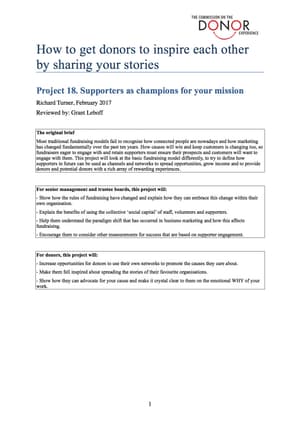CDE project 18 section 3.7: action 8 — set up new measures
- Written by
- The Commission on the Donor Experience
- Added
- April 12, 2017
Adopting a mindset of how to inspire people to spread your story rather than target them for money will need new measures away from direct ROI.
You will also need to do activities that engage people, in order to help communicate your story, maintain their attention and activate them to advocate on your behalf. These activities may not deliver a high ROI. So, to apply this approach of supporters as advocates, you need to view fundraising holistically and see how it all connects, i.e. the ROI that really matters is the overall ROI. As the case example provided by SolarAid in Action 4 illustrates, an activity that provides high engagement but low ROI may lead to income that appears in another income area later. As the NSPCC Full Stop campaign illustrates in Action 5, by removing team targets you can encourage teams to work together better.
As the saying goes, 'You need to measure what you want to happen.'
Grant Leboff, author of Digital Selling, offers this guidance:
You should have three measurements:
- Your first measure should be how many people are in your ecosystem. So that would include numbers on your database (not just donors) and followers on social media. But that measure shouldn't be in a vacuum - it should be against your market. This will also force you to define your market. So now who have a % KPI of your total ecosystem against your market audience. This will also force you to understand who your supporters are.
- Of people in your ecosystem how many are engaged with you e.g. donate, fundraise, send you an email, watch a video from your website, download content, open an e-newsletter. You need to choose a period you measure this over - no less than quarterly. You will also need a CRM that interacts with your database. Question to ask: how can you increase engagement by the next quarter?
- Of the people engaged how many are donating, or fundraising, or getting others to donate or fundraise. Question to ask: How do I get those engaged to give more or more often or get others to do so?
Also, consider measuring and capturing:
- The number of inbound leads and unsolicited donations you receive each week. Also record why someone gave to you and noting any ‘sticky’ examples, i.e. instances of donors choosing to support you as a result of hearing your story through someone they know or by learning about your reputation.
- The quality of the donor experience you provide. Can you collect feedback at the moment of giving, even to the extent of inviting a donor review similar to those placed on sites like Amazon?
Please read CDE Project 3: Measuring satisfaction and loyalty – how your donors feel compiled by Roger Lawson. ‘We believe that an obsession with short-term financial KPIs is the single biggest reason that donors are dissatisfied with the way charities fundraise.’
Recommended further reading:
Measuring the Network Non-Profit by Beth Kanter


















